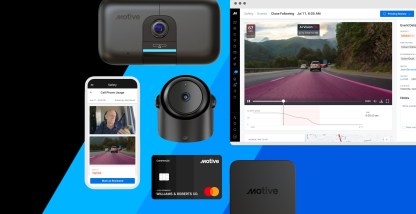A former safety exec explains why consolidating to a single platform is still the best way forward.
As the economy has slowed in the last few years, merger activity has too. Global M&A value declined 44% in the first half of this year, and volume was down 37%. With a drop in mega-deals, executives are counting on mid-market transactions to drive transformation and growth. As CEOs look to prove they have a sound AI strategy, AI-based deals are a rare bright spot in the M&A forecast.
But even the best tech deals are no guarantee of success. After a merger, some leaders may treat tech integration as an afterthought. That would be a mistake when consolidation is critical to a deal’s success. Victor Malchesky, a former VP of Safety for Swift Transportation, has seen technology integrations work, and the benefits that emerge when they do. In a conversation with Motive, Malchesky shows why integrating to a single integrated platform can be such a game changer for fleet operations.
Why to integrate your tech stack
To understand the value of integration, transportation businesses must understand what can happen when they don’t integrate. For example, fleets may suffer from:
- Lost data
- Reduced productivity
- Untimely feedback
- More accidents
- Higher costs
- Lower ROI
Consolidating technologies on a single platform eliminates these problems and creates benefits like those below.
More consistent results
“Southwest Airlines became successful because they had one type of plane and a consistent formula that worked,” Malchesky notes. “That wasn’t a fluke. The lessons of consistency apply to commercial fleets on the road just as they do in the sky.”
Why consistency matters: Having the uniformity of one system enables teams to work in the same environment and speak the same language.
Where to start: An integrated operations platform, like the one from Motive, lets businesses manage all their operations in one place. By accessing Driver Safety, Fleet Management, Spend Management, and Equipment Monitoring on a single platform, companies get the visibility and control they need to become safer, more productive, and more profitable.
More buying power
Having a unified operations platform allows businesses to fight for pricing based on their scale. If a small organization is coming into a larger one, for example, they’re gaining buying power through the deal. As a larger organization, the value of the dollar will go farther on one platform.
After an acquisition, consolidating technologies needs to be part of the big picture. Says Malchesky: “There has to be a time when the safety department comes together to learn what’s being done and which technology investments make sense for the organization.”
Clean reports, clear understanding
Safety thresholds and data interpretations are different from one system to the next. When Malchesky rolled out dash cameras for one fleet, for example, he tested two different vendors and the results weren’t the same. One triggered an unsafe event, the other didn’t.
The benefit of clean reporting: “If you’re working with two dash cam systems, inconsistency creates issues with driver coaching and coaching effectiveness,” says Malchesky. “When you’re gathering data and trends, it’s much easier to go to one system and get one report. When everyone’s performance is measured the same, you’ll get clean reports that show where opportunities exist and how to drive improvement.”
Tools like the Motive Coaching Dashboard streamline the coaching process, making it faster and more effective. The most relevant videos, speeding events, and coaching history are surfaced in one view, so managers can provide personalized, timely feedback. You’ll see everything at a glance, including:
- Drivers who need coaching
- The behaviors they need to be coached on
- Each driver’s risk score
- Performance trends over time
Having clear visibility into each of these metrics allows fleet managers to pinpoint areas of improvement and reward drivers as they grow.
How to integrate your tech stack
Integrating technologies is a strategic decision that requires years of planning and a firm understanding of where your program needs to go. By eliminating redundant roles and initiatives, companies can deliver products and services faster. While integration is important, it’s not easy. Following the tips below will make it easier.
Retain policies and roles that add value
After a merger, some businesses may want to start fresh. As they clean house, processes that work get discarded with those that don’t.
“When you’re the one acquiring, it’s easy to say, ‘This is how we’re going to do things now,’” Malchesky says. “You tend to lose some of the good that made the company an attractive acquisition. Policies and procedures that could be learned from suddenly get lost. It’s important to learn from the acquired business and understand what they do and how they do it.”
Show employees they have a voice
After an acquisition, employees may feel uncertain. Do your best to make everyone feel represented. The ultimate goal is to make your new team that much more successful. “Success will come more quickly when people from both sides come together to share ideas,” Malchesky says. “It doesn’t matter which side of the deal you’re on. Everybody should feel that they have a voice and the opportunity to share their expertise.”
Integrate technologies at a smart pace
Plan for the long term: It’s never wise to shake things up on Day One. That level of disruption creates fear and distrust. The pace of integration is often dictated by contract terms anyway. “Have some kind of roadmap that’s been agreed upon,” Malchesky notes. “It should be a one- or two-year plan that addresses when specific changes will take place and what makes the most business sense.”
Why a roadmap is needed: Not having a carefully planned roadmap leads to inefficiency and waste. If a fleet just bought brand new dash cams, for example, does it make sense to just throw them away? Or could they be resold? “Take all of that into consideration, and have an agreed upon goal that brings your vision together,” Malchesky says. “Be able to picture what the final structure will look like.”
What’s your consolidation plan?
Do you have a consolidation plan? Motive can help. More than 120,000 companies use Motive to transform the safety, productivity, and profitability of their operations. Discover what Motive can do for your company.










